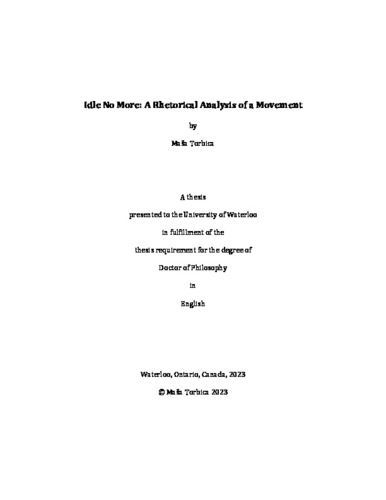| dc.description.abstract | This project investigates discursive and material constraints against and possibilities for decolonial resistance and existence by rhetorically analyzing key features of the Idle No More movement. Since November 2012, Idle No More has been an active, Indigenous-led, grassroots social justice movement advocating for environmental protections and Indigenous rights. I contribute additional insights about the movement’s cumulative impacts by interrogating two defining features of its emergent phase (flash mob round dances and social media activism) and its relation to reconciliation-based and resurgence-based approaches to decolonization. Foregrounding structural and symbolic violence against Indigenous women, girls, and 2SLGBTQQIA people as a foundational feature of settler colonialism, I outline how Idle No More-affiliated round dances challenge the gendered constraints of coloniality. Next, reading the Twitter hashtag “#Ottawapiskat” as a successful reframing of colonial attempts to delegitimize Indigenous political activism, I argue that Idle No More digital activism is characterized by dynamic interactions between discursive and embodied interventions. Turning toward the temporal overlap between the movement’s emergence and the proceedings of the Truth and Reconciliation Commission of Canada, I find that state and public responses to Idle No More illustrate the limits of pursuing decolonial aims through the institutions and discourses of the settler state. Finally, examining a resonant example of resurgence-based initiatives within the Idle No More movement, I posit that youth-led long walks like the Journey of Nishiyuu constitute embodied and emplaced testimonies of survivance. Foregrounding existing insights by Indigenous scholars, artists, and activists, I identify and evaluate how systemic constraints on inherent Indigenous sovereignty become sites of active contention and subversive political struggle. In doing so, I assert that the Idle No More movement can be understood as an ongoing revitalization of the third space(s) of sovereignty. Altogether, this project challenges normalizations of settler colonialism as an unalterable reality by actively anticipating futures informed by other sociopolitical realities: ones which already existed before and will continue to exist beyond currently dominant power structures. | en |

